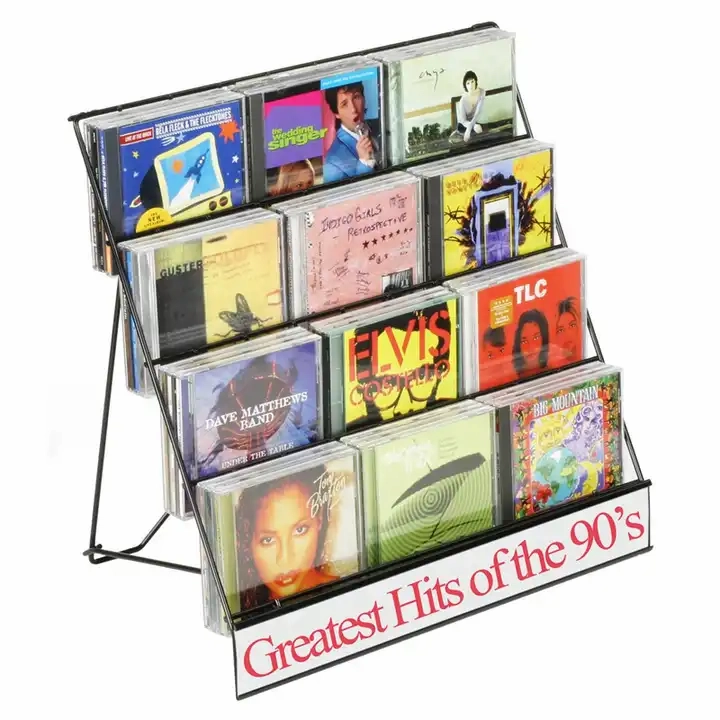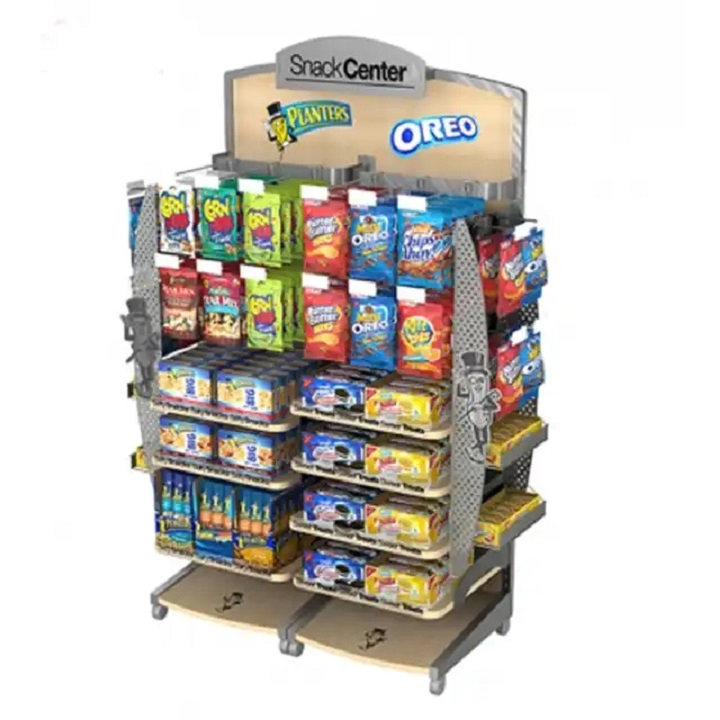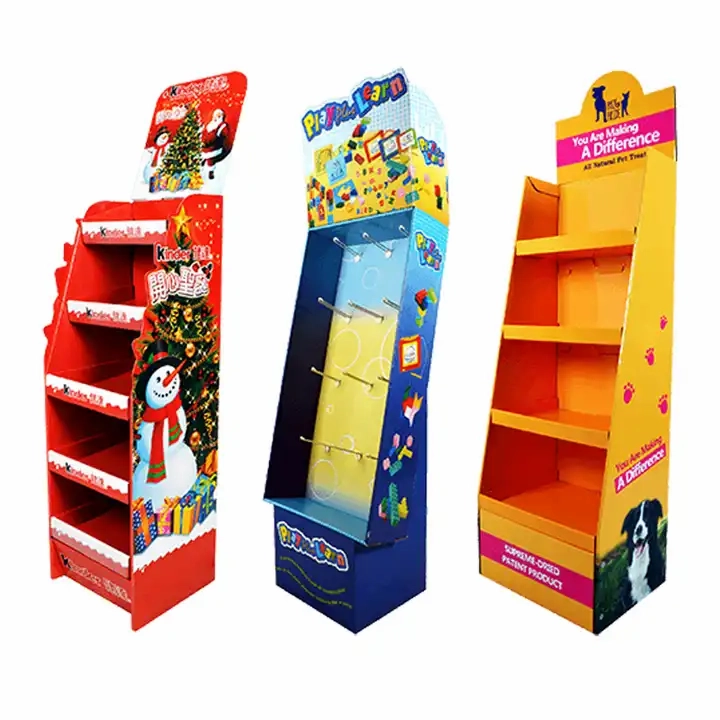Content Menu
● Why Eco-Friendly Display Stands Matter
● Key Materials for Sustainable Display Stands
>> Recycled Cardboard and Paperboard
>> Bamboo
>> FSC-Certified Wood
>> Recycled Plastics (RPET, HDPE)
>> Corrugated Fiberboard
● Benefits of Eco-Friendly Display Stands for Retailers
● Types of Eco-Friendly Display Stands
>> Floor Display Stands
>> Countertop Display Stands
>> Hanging and Wall-Mounted Display Stands
>> Modular Display Systems
● Design Innovations in Sustainable Display Stands
● Real-World Retail Examples
>> Fashion Industry
>> Electronics and Tech Stores
>> Food and Beverage
● How to Choose the Best Eco-Friendly Display Stands
>> Define Usage Requirements
>> Evaluate Material Options
>> Assess Customization Capabilities
>> Consider Assembly and Portability
>> Plan for End-of-Life Management
● Custom Eco-Friendly Display Solutions
● The Role of Display Stands in Brand Storytelling
● Maintenance and Care for Eco-Friendly Display Stands
● Overcoming Myths About Sustainable Display Stands
>> Myth 1: Eco-Friendly Display Stands Aren't Durable
>> Myth 2: Sustainable Display Stands Limit Design Creativity
>> Myth 3: Eco-Friendly Display Stands Cost Significantly More
>> Myth 4: Sustainable Display Stands are Just a Trend
>> Myth 5: Recycling Infrastructure for Eco Stands is Inadequate
● Future Trends in Eco-Friendly Display Stands
● Conclusion
● Frequently Asked Questions (FAQ)
>> 1. What are the main benefits of using eco-friendly display stands in retail?
>> 2. Which materials are best for sustainable display stands?
>> 3. How can display stands be customized to fit my brand?
>> 4. Are eco-friendly display stands suitable for outdoor use?
>> 5. What happens to display stands at the end of their lifecycle?
In today's diligent pursuit of sustainability, retailers across the globe are transitioning toward environmentally conscious solutions in every aspect of their business. Among these, eco-friendly display stands have risen as a top priority for brands aiming to showcase products responsibly while appealing to modern consumers who value green practices. The right display stands not only serve as practical merchandising tools but also as tangible expressions of a brand's commitment to environmental stewardship.
Display stands have historically ranged from plastic and metal constructs to elaborate woodwork. However, the drive for reduced carbon footprints, responsible sourcing, and recyclability has transformed the landscape, birthing an era of sustainable display stands crafted for both functionality and environmental care. In this definitive guide, we'll explore the best eco-friendly display stands, analyze their benefits, showcase real-world implementations, and help retailers select the ideal green solution for any setting.

Why Eco-Friendly Display Stands Matter
Retail environments are dynamic, visually rich spaces designed to entice and convert shoppers. Yet, traditional display stands can contribute significantly to waste and pollution due to their materials, short lifespans, and challenging recyclability. Eco-friendly display stands address these issues, offering:
- Reduced Waste: Made from recyclable, biodegradable, or reusable materials.
- Lower Carbon Footprint: Created using processes and materials that emit less greenhouse gases.
- Brand Differentiation: Consumers increasingly seek brands demonstrating genuine care for the planet.
- Cost Efficiency: Many sustainable options are designed for multi-use and are easier to recycle at end-of-life, reducing long-term costs.
This shift reflects a broader cultural and economic change toward sustainable retailing. In fact, incorporating display stands that are environmentally responsible is becoming a marker of quality and trustworthiness. Studies show that shoppers, especially younger generations, gravitate toward retailers whose packaging and merchandising materials align with their values.
Key Materials for Sustainable Display Stands
Eco-friendly display stands come in a variety of materials, each with unique advantages. The most popular sustainable materials include:
Recycled Cardboard and Paperboard
Recycled cardboard is among the most popular materials for eco-conscious display stands. Lightweight and versatile, it suits point-of-sale displays, promotional kiosks, and brochures. Its printability allows vivid graphic representations, making it visually striking despite its humble origins. Additionally, cardboard stands are inexpensive to produce and easy to recycle after use, reducing waste streams especially from seasonal or limited-edition campaigns.
Bamboo
Bamboo is rapidly becoming the material of choice for premium eco-friendly display stands. It grows much faster than hardwood trees, making it a highly renewable resource. Bamboo possesses an appealing natural grain and strength comparable to many woods, allowing it to support heavy products while enhancing a brand's earthy aesthetic. Its biodegradability and renewability make it ideal for retailers targeting environmentally savvy consumers who appreciate authenticity.
FSC-Certified Wood
The Forest Stewardship Council (FSC) certification ensures that wood comes from responsibly managed forests that provide environmental, social, and economic benefits. Using FSC-certified wood for display stands guarantees sustainably harvested materials. Such stands tend to be durable and stylish and can be designed to suit rustic or modern retail environments. FSC certification also reassures customers of a brand's sustainability commitment.
Recycled Plastics (RPET, HDPE)
Recycled plastics such as RPET (recycled polyethylene terephthalate) and HDPE (high-density polyethylene) play an important role in eco-friendly display stands that require durability and weather resistance. By incorporating plastics recovered from bottles and packaging, manufacturers reduce landfill waste and promote a closed-loop economy. These plastics are ideal for indoor and outdoor use, combining toughness with lighter environmental impact compared to virgin plastic.
Corrugated Fiberboard
Corrugated fiberboard is an engineering marvel in sustainable displays — weaving strength with lightness. It can be cut and folded into complex shapes that support mid-level weight, making it an excellent material for custom shapes and sizes. Additionally, this fiberboard is fully recyclable, and many are made from a majority of recycled content. Corrugated options are prevalent in pop-up displays and temporary retail activations.

Benefits of Eco-Friendly Display Stands for Retailers
Switching to sustainable display stands yields numerous benefits for retailers beyond environmental impact:
- Brand Loyalty: Customers increasingly reward businesses that make genuine efforts toward sustainability. Eco-friendly display stands demonstrate accountability and enhance customer trust.
- Compliance with Regulations: Some jurisdictions enforce mandates on packaging, retail waste, or recycling rates. Using green display stands helps stores stay ahead of regulations and avoid penalties.
- Adaptability: Many eco-friendly stands utilize modular components, allowing quick reconfiguration for different campaigns or products without buying new stands.
- Positive Public Relations: Sustainable choices create compelling brand stories and garner media attention, thus creating valuable marketing opportunities.
Moreover, eco-friendly display stands often bring operational gains. Their lighter weight can reduce shipping costs, and their simplified assembly designs minimize labor during setup. Choosing renewable materials aligns retailers with circular economy principles, emphasizing reuse and recycling over disposal.
Types of Eco-Friendly Display Stands
Floor Display Stands
Floor stands are freestanding, robust units that often make the first impression in a retail store. Sustainable versions are made from recycled cardboard, bamboo, or FSC-certified wood. They support bulk merchandise, large graphics, and sometimes interchangeable panels, providing retailers flexibility and a strong eco-conscious image. These floor stands fit right into stores emphasizing minimal environmental impact without compromising aesthetics or stability.
Countertop Display Stands
Ideal for smaller spaces such as checkout counters or promotional areas, countertop displays maximize impact within limited footprints. They commonly use corrugated fiberboard, recycled acrylics, or paperboard laminates. These displays emphasize portability and ease of replacement, serving impulse buyers and smaller product collections. Countertop eco-friendly display stands can be recycled or composted after use, reducing retail waste substantially.
Hanging and Wall-Mounted Display Stands
Using vertical space efficiently, hanging and wall-mounted stands appeal particularly to stores with limited floor area. Constructed with minimal packaging materials and easy installation hardware, they add merchandising space with a low environmental footprint. Lightweight materials, such as recycled plastics or cardboard, allow quick assembly and removal, making these stands ideal for temporary or seasonal displays.
Modular Display Systems
Modularity is a crucial characteristic in sustainable display solutions. Modular stands feature components that snap or lock together without permanent adhesives or hardware, allowing retailers to update formats, resize units, or completely disassemble them after campaigns. This adaptability extends the lifespan of the display stands and reduces total waste. Modular eco-friendly display stands often incorporate recycled materials and leverage flat-pack construction for efficient shipment.
Design Innovations in Sustainable Display Stands
Innovative design tools have expanded what eco-friendly display stands can offer:
- Flat-Pack Construction: Many modern sustainable stands are engineered to disassemble flat, substantially minimizing volume during shipping. This transport efficiency reduces carbon emissions and costs.
- Tool-Free Assembly: Clever interlocking tabs and joints replace screws and glue, making setup easier and recycling at end-of-life more straightforward.
- Minimalism: Designers focus on reducing material usage without sacrificing functionality, opting for sleek profiles that maintain load-bearing capability while using less.
- Digital Printing with Eco-Inks: Water-based and UV-curable inks allow vibrant visuals on recyclable substrates without toxic chemicals.
- Smart Integration: Some stands incorporate embedded digital screens and e-paper displays within recyclable packaging, blending sustainability with interactive technology.
Such design features prove that sustainability and creativity can thrive together, resulting in display stands that stand out both visually and ethically.
Real-World Retail Examples
Fashion Industry
Fashion brands increasingly adopt modular bamboo and cardboard display stands to rotate seasonal collections efficiently. For example, a high-end clothing retailer may use beautifully crafted bamboo stands for permanent showroom displays, while employing recycled cardboard for temporary promotions. These stands disassemble into flat components, enabling storage reuse and minimizing waste between campaigns.
Electronics and Tech Stores
Durability and aesthetics are both critical in tech retail environments. Recycled plastic display stands, combined with FSC-certified wooden elements, present products securely while broadcasting an eco-conscious message. Lockable compartments and clean lines illustrate sustainable innovation without compromising product visibility or security.
Food and Beverage
Organic grocery stores and specialty food brands prioritize compostable, paper-based display stands for events and new product launches. These eco-friendly units align fully with natural product messaging and reassure consumers that the ethos is consistent throughout the supply chain.
How to Choose the Best Eco-Friendly Display Stands
Selecting the perfect eco-friendly display stand requires careful consideration:
Define Usage Requirements
Start with a clear understanding of:
- Whether the stand is for temporary, seasonal, or permanent installation.
- The product size, fragility, and weight it must support.
- The environmental conditions—indoor, outdoor, or semi-exposed environments.
Evaluate Material Options
Choose materials not only for sustainability credentials such as recyclability or certification but also for durability and appearance. FSC-certified wood or bamboo suits permanent displays, while recycled cardboard excels in short-term, lightweight applications.
Assess Customization Capabilities
Eco-friendly display stands should reflect your brand's identity. Look for suppliers who offer custom shapes, striking eco-friendly printing with water-based inks, and finishes that highlight your message without compromising the environment.
Consider Assembly and Portability
Lightweight, tool-free, flat-pack designs save labor and storage space. Retailers often benefit from stands that store compactly and ship efficiently to multiple store locations.
Plan for End-of-Life Management
Ensure your displays have clear pathways for recycling, composting, or return to manufacturers for repurposing. A responsible end-of-life strategy completes the sustainability cycle.
Custom Eco-Friendly Display Solutions
There is growing demand for bespoke eco-friendly display stands tailored precisely to product needs and brand values. Working with OEM partners familiar with sustainable materials and innovative printing processes enables fully customized solutions that:
- Support complex shapes or unique display forms.
- Incorporate recyclable glosses and matte finishes.
- Adhere strictly to clients' environmental standards.
Such collaborations allow brands to impress customers with eye-catching displays that tell stories of responsible sourcing and manufacturing.
The Role of Display Stands in Brand Storytelling
Display stands are silent ambassadors of brand values. Beyond their merchandising function, eco-friendly display stands communicate narratives of commitment to environmental principles, craftsmanship, and social responsibility. Careful selection of materials, finishes, and design speaks volumes to consumers increasingly demanding transparency and ethical business conduct. An eco-friendly display stand is a tangible tool in building brand trust and loyalty.
Maintenance and Care for Eco-Friendly Display Stands
To maximize the lifespan and performance of eco-friendly display stands:
- Clean regularly with natural, non-toxic solutions, avoiding harsh chemicals that degrade material integrity.
- Prevent moisture accumulation, particularly when using cardboard or paperboard, to avoid warping.
- Handle assembly and disassembly gently to preserve structural components.
- Follow recycling or composting instructions provided by manufacturers once displays reach end-of-life.
Proper care helps display stands deliver sustained benefits and reduces replacement frequency.
Overcoming Myths About Sustainable Display Stands
Myth 1: Eco-Friendly Display Stands Aren't Durable
Today's eco-friendly materials and advanced designs ensure display stands can support heavy merchandise and withstand retail conditions as well as traditional options.
Myth 2: Sustainable Display Stands Limit Design Creativity
Digital printing, laser cutting, and modular engineering provide abundant design freedom, allowing retailers to express brand identity vibrantly and uniquely.
Myth 3: Eco-Friendly Display Stands Cost Significantly More
When considering total lifecycle—including shipping, storage, setup, and end-of-life disposal—many sustainable options offer comparable or lower overall costs.
Myth 4: Sustainable Display Stands are Just a Trend
Sustainability in retail design responds to fundamental shifts in consumer awareness and global environmental challenges, making eco-friendly displays a durable, evolving standard.
Myth 5: Recycling Infrastructure for Eco Stands is Inadequate
More regions and waste management systems now support recycling and composting of eco display materials, and many manufacturers offer take-back programs to close the loop.
Future Trends in Eco-Friendly Display Stands
The future of sustainable display stands is poised for exciting advances:
- Bio-Based Plastics and Composites: Materials derived from plants offer strength with compostability.
- Smart Displays: Sensor-enabled, light-weight digital displays built within recyclable enclosures.
- Circular Economy Models: Retailers and manufacturers collaborate on rental, reuse, and repurposing of display stands.
- Enhanced Biodegradability: Innovations in coatings and adhesives reduce environmental impact even more.
- Integration with Sustainable Packaging: Combined solutions for product packaging and display reduce overall material consumption.
Retailers investing early in these trends position themselves as leaders in sustainable commerce, attracting eco-conscious consumers and future-proofing their brand.
Conclusion
Eco-friendly display stands are redefining retail environments by creatively combining aesthetic appeal with environmental responsibility. Moving away from traditional plastic and non-renewable materials, retailers today leverage recycled, renewable, and responsibly sourced materials to craft display stands that resonate deeply with the green values of modern consumers.
Adopting sustainable display stands offers tangible benefits: reducing waste and carbon footprints, fostering customer loyalty, complying with regulations, and enhancing public relations. Through thoughtful design, innovative materials, and end-of-life management, these display solutions exemplify how retail success and sustainability go hand in hand.
The future of retail presentation is green, dynamic, and purposeful—and eco-friendly display stands are at the forefront of this transformation.

Frequently Asked Questions (FAQ)
1. What are the main benefits of using eco-friendly display stands in retail?
Eco-friendly display stands offer many advantages such as reduced environmental impact, lower lifecycle costs, enhanced brand loyalty, regulatory compliance, and strong public relations. They help retailers meet consumer demand for responsible business practices while boosting operational efficiencies.
2. Which materials are best for sustainable display stands?
Top eco-friendly materials include recycled cardboard and paperboard, bamboo, FSC-certified wood, recycled plastics like RPET and HDPE, and corrugated fiberboard. Each material offers distinct benefits in sustainability, strength, and design flexibility.
3. How can display stands be customized to fit my brand?
Many suppliers provide custom design services using eco-friendly materials, enabling unique shapes, sizes, eco-conscious printing, and finishes that elevate brand storytelling without compromising sustainability.
4. Are eco-friendly display stands suitable for outdoor use?
Yes, certain eco-friendly materials such as recycled plastics and treated FSC wood are suitable for outdoor conditions. Choosing the correct material based on environment and longevity requirements is critical.
5. What happens to display stands at the end of their lifecycle?
Depending on the material, eco-friendly display stands can be recycled, composted, or returned to manufacturers for repurposing or responsible disposal. Planning end-of-life management ensures minimal environmental impact.
































